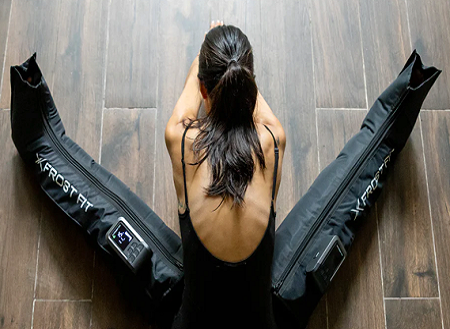Recover Like a Pro: The Power of Leg Compression for Athletes
 Recovery is now a fundamental part of training for athletes at all levels. Whether you’re a professional athlete or a workout enthusiast, how fast you recover affects how well you can perform.
Recovery is now a fundamental part of training for athletes at all levels. Whether you’re a professional athlete or a workout enthusiast, how fast you recover affects how well you can perform.
That’s why many are opting for leg compression. It is a simple and effective method to lessen soreness, improve blood circulation, and reduce turnaround time for muscle reconditioning.
This method includes applying gentle pressure on your legs to help your body heal after exercise. It’s beneficial, fits easily in your routine, and, most importantly, it feels good. So, more and more athletes are using it.
However, how can you add leg compression therapy to your rehabilitation plan, and why is it so beneficial?
In this article, we’ll break down how it works, the science behind it, and the benefits it provides you so you can recover better and get the most out of every workout.
What Is Leg Compression?
Leg compression is a recovery tool that uses controlled pressure to help your legs recover after exercise. Commonly, it involves special air-filled compression boots that squeeze your legs in a wave-like pattern.
It helps with improving blood flow, reducing swelling, and flushing out waste, like lactic acid, from tired muscles. It can be a lifesaver for athletes. After a tough workout or competition, leg compression can help reduce soreness and speed up muscle recovery.
That’s why leg compression for athletes is a smart investment for anyone who wants enhanced performance, recovery, and long-term muscle health. Beyond recovery, these devices also allow athletes to remain consistent with training by decreasing downtime due to fatigue or soreness.
Benefits of Leg Compression for Athletes
Below are some key benefits of leg compression that can help athletes recover quicker and perform better
1. Faster Muscle Recovery
Faster muscle recovery is one of the biggest benefits of leg compression for athletes. Post-workout, competition, or after intense training, muscles tend to be sore, tight, and fatigued.
That said, leg compression therapy improves blood circulation and speeds up the recovery process. Its rhythmic pressure helps push out waste and excess fluid while encouraging fresh, oxygen-rich blood to flow to the muscles.
As a result, it reduces inflammation and swelling, which are usually the main culprits behind post-exercise soreness. Therefore, athletes feel less muscle pain and stiffness the next day.
In short, you can return to training sooner, be consistent with your training schedule, and make constant improvements in performance.
2. Improved Circulation
Endurance athletes such as runners, cyclists, and triathletes need good circulation to aid in athletic recovery and performance.
Their muscles demand a constant stream of oxygen and nutrients as their body goes through long or intense sessions. They also generate waste products like carbon dioxide and lactic acid, which must be removed efficiently.
For this reason, leg compression helps veins push blood back toward the heart by applying rhythmic pressure to the legs. In turn, enhanced blood flow brings fresh oxygen and nutrients to tired muscles and speeds up the removal of waste.
Eventually, its prolonged use even promotes long-term vascular health and overall circulation. In other words, athletes experience faster muscle repair, less fatigue, and faster recovery between training sessions.
The result?
Their body performs better and bounces back quicker with better circulation.
3. Reduced Inflammation
After a hard workout or training session, muscles and joints tend to be swollen or sore. It’s due to inflammation, a natural part of the healing process. In most cases, inflammation is good, but if it remains too long, it will slow recovery and impede performance.
For athletes, leg compression is a simple and effective method to treat such post-exercise inflammation. In this context, compression boots apply gentle pressure to move fluid through the legs, supporting circulation and lymphatic drainage.
As a result, it empties out waste products and decreases swelling of the muscles and tissues. So, athletes who use leg compression on a regular basis tend to be less troubled by pain in their legs, particularly after high-impact activities or heavy strength training.
Compression therapy helps to control inflammation, keeping recovery smooth and consistent, so they can keep pushing forward.
4. Injury Prevention
Not having an injury is as important as increasing strength or endurance for athletes with highly demanding training schedules. So, if you need to train hard to make progress, injury prevention is essential to keep your body strong and resilient.
Further, if the body does not recover properly, there is an increased risk of overuse injuries, muscle strains, and joint problems. That is especially true in the case of athletes who train frequently or at high intensities.
However, by promoting healthy circulation and reducing post-workout swelling, leg compression helps reduce that risk. It helps keep muscles and connective tissues in better condition between sessions by flushing waste products and bringing in fresh nutrients.
That means less stiffness or imbalances and a much lower chance of strain or fatigue-related injuries. Plus, if the body recovers well, it is going to be better prepared for the next workout and less likely to break down with repeated stress.
So, when athletes want to train smarter, leg compression can be an extremely valuable tool in preventing long-term injuries.
Conclusion
Athletic recovery is no longer just about taking a rest day or drinking a protein shake. Modern recovery tools like leg compression therapy offer real, science-backed benefits that help athletes train harder, recover faster, and perform better.
On that note, this therapy provides the mentioned benefits, like faster muscle recovery, improved circulation, reduced inflammation, and injury prevention. Moreover, it is a passive or at-home recovery method that can be used with minimal effort.
So, if you’re serious about your performance and want to recover like a pro, you should use leg compression now.